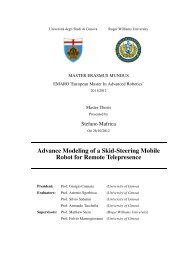SECCM Assessment Plan - Roger Williams University
SECCM Assessment Plan - Roger Williams University
SECCM Assessment Plan - Roger Williams University
Create successful ePaper yourself
Turn your PDF publications into a flip-book with our unique Google optimized e-Paper software.
Section<br />
3<br />
<strong>Assessment</strong> <strong>Plan</strong> for the Computer Science<br />
Program<br />
Introduction<br />
The Computer Science Program is founded on an educational philosophy that encourages<br />
exploration and discovery in a dynamic discipline. Students study computer science in an<br />
environment which goes beyond disciplinary boundaries and enhances the development of the<br />
“whole” person. The curriculum is designed to develop the essential knowledge, skills and abilities<br />
needed for professional practice or graduate study. The curricular structure of the program, coupled<br />
with the strong influence of the liberal arts, equips our graduates with a “holistic” educational<br />
experience that prepares them to succeed in a world characterized by rapidly increasing technology,<br />
growing complexity and globalization.<br />
The computer science program is designed to encompass seven functional categories of courses:<br />
• Algorithms<br />
• Data Structures<br />
• Software Design<br />
• Concepts of Programming Languages<br />
• Computer Organization and Architecture<br />
• Mathematics and Science<br />
• General education.<br />
Each of these categories provides the student with an essential component of their overall<br />
educational experience. The interleaving of the courses provides a synergistic curriculum that<br />
ensures students are prepared for successful computer science practice.<br />
Curricular Functional Design<br />
As discussed above, the computer science curriculum is designed around seven functional categories<br />
of courses. Many of the courses are common to most undergraduate computer science programs.<br />
The program follows many of the tenets as set forth in the ABET/CAC criteria and the ACM<br />
Computing Curriculum 2001. There are a total of 121 credit hours required for the computer science<br />
degree broken down as depicted in Table 3.1.<br />
47
















